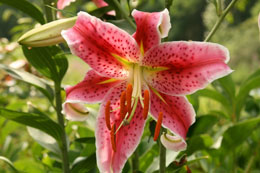Here are some Oriental Lily care tips that will help you enjoy the resplendent beauty of these magnificent flowers year after year.

A species belonging to the genus
Lilium, oriental lilies have an extremely high commercial value. They, along with a few other members of its genus, are highly favored as commercial cut flowers. This flower can be easily grown in home gardens too with a little bit of information about its bulb handling, planting, growth habits, and care.
Oriental lilies are hybrids developed from crossing East Asian species. This hybrid produces larger flowers with a wide color range, such as white, pink, red, apricot, plum, and yellow; in varying shapes, such as trumpet, recurved, bowl-shaped, furled edges, etc.; and different patterns, like stripped, ribbed, or plain. A plant from a single bulb attains a height of around 24-36 inches and will carry several flowers that bloom successively on one stem. Each flower looks spectacular, as there is an interplay of shades within the same color, and the petal edge is a shade lighter than the center. Each flower has six prominent anthers that contain pollen.
How to Grow
Oriental lily cultivars vary height wise from around 18 inches to 5 feet tall. One can get healthy bulbs from most nursery stores. The bulbs can be rounded or oblong in shape, and they must be firm and free of any fungal growth. One can even use last season's stored bulbs. Popular fragrant long-time bloomers include the hybrid varieties Stargazer and Casa Blanca.
The bulbs should be planted in a location that receives four to six hours of full sunlight. They can also be planted in pots and placed indoors in a spot that is well-lit. The soil should be well-drained and fertile, with lots of organic compost added to it. Avoid fertilizing the soil. Maintain the soil pH balance around 5.6-6.5. Bulbs can be started after the last frost date for an early flowering or February and March for a late summer bloom. Space the bulbs 9-12 inches apart when planting in clumps or individually when in pots. The depth should be enough to take in the entire bulb along with the root ball. Mound the soil, leaving only an inch of the bulb tip uncovered. Plant the bulbs early in the morning or late in the evening, and water them thoroughly.
Care
One can even mulch around the bulbs with straw or grass to keep them cool and the area weed-free. However, mulching is optional. Within a couple of months, lots of leaves will sprout and new flower stalks will begin to appear. Fertilize with a low-nitrogen fertilizer only when the buds begin to appear. As flowers begin to bloom and wilt away, keep removing dead flower heads to encourage successive blooming. If you want to enjoy these blooms as cut flowers, simply cut half the stalk. Never cut the foliage, as it is needed to ensure the plant's vitality. Cut the flower's stems early in the morning.
Once all the flowering is spent, continue watering the plant until the stem and leaves turn yellow on their own account. Give the plant a hard prune till the base. One can allow the bulbs to stay in the ground and multiply, or remove and store them until the next planting season. Bulbs left in the ground should be divided every three years. Allow the bulbs to dry naturally in a ventilated place, dust them with some germicidal powder, and store in a mesh bag.
Oriental lilies create a dramatic visual impact when mass planted. However, these beautiful blooms can be grown individually too. With the numerous colors, shapes, and sizes that these flowers offer, one will have a vibrant summer flower garden.






 A species belonging to the genus Lilium, oriental lilies have an extremely high commercial value. They, along with a few other members of its genus, are highly favored as commercial cut flowers. This flower can be easily grown in home gardens too with a little bit of information about its bulb handling, planting, growth habits, and care.
A species belonging to the genus Lilium, oriental lilies have an extremely high commercial value. They, along with a few other members of its genus, are highly favored as commercial cut flowers. This flower can be easily grown in home gardens too with a little bit of information about its bulb handling, planting, growth habits, and care.